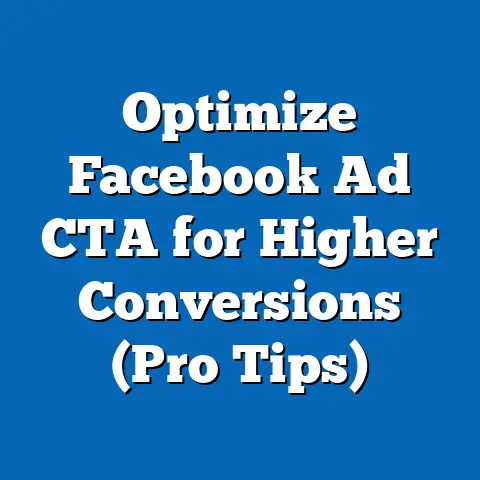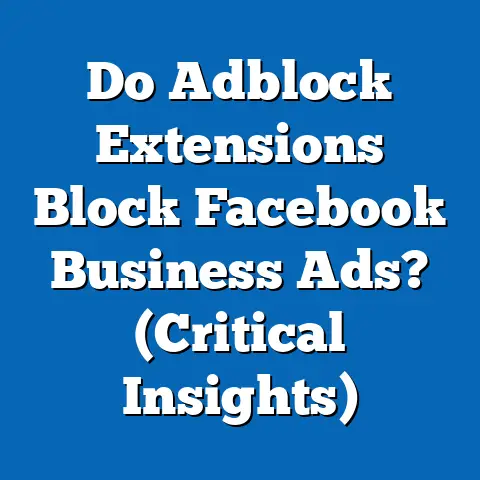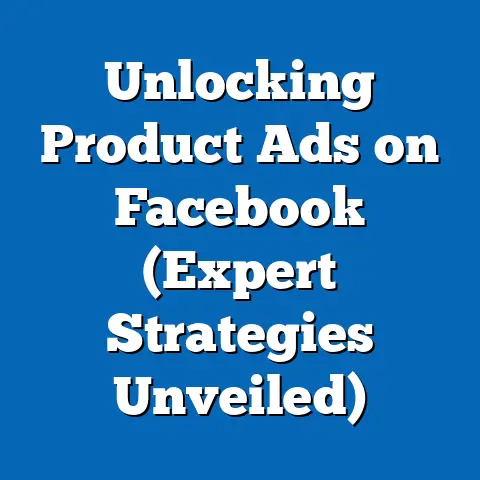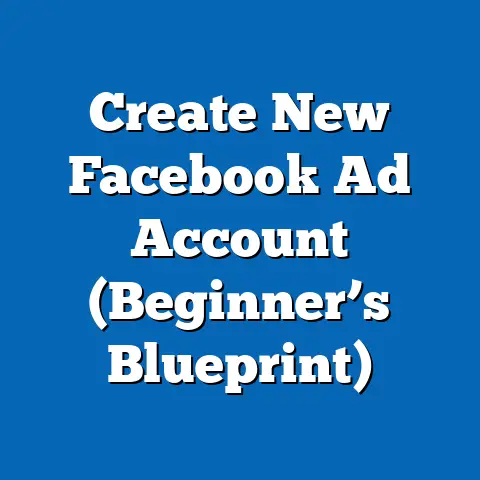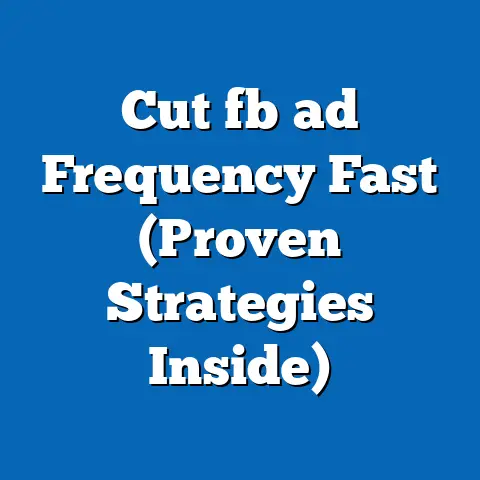Unlocking HTML in Facebook Ads (Strategic Insights Revealed)
If navigating Facebook Ads were a sport, it would certainly be an extreme one—complete with thrilling highs, gut-wrenching lows, and the occasional faceplant into a pool of pixelated confusion. It’s a world of algorithms, bidding strategies, and creative executions, where even the most seasoned marketers can feel like they’re perpetually playing catch-up. But fear not, fellow advertisers! Today, I’m going to demystify a secret weapon that can significantly boost your Facebook ad game: HTML.
The Basics of Facebook Ads
Facebook Ads, in essence, are the digital billboards of the 21st century. They’re a powerful tool that allows businesses to reach a hyper-targeted audience with compelling messages. Their significance in the digital marketing landscape is undeniable. With billions of active users, Facebook offers unparalleled reach and the ability to connect with potential customers based on demographics, interests, behaviors, and more.
How do they work? Well, it’s a complex dance of targeting, placement, and bidding. You define your ideal customer, choose where you want your ad to appear (Facebook feed, Instagram stories, etc.), and then bid against other advertisers to show your ad to that audience. It’s a constant auction, and the better you understand the mechanics, the more likely you are to win – and win big.
Now, where does HTML fit into this picture? While Facebook Ads Manager offers a user-friendly interface to create ads, it can sometimes feel limiting. This is where HTML comes in as a way to enhance and customize your ads beyond the standard options. Think of it as the secret sauce that can make your ads stand out from the crowd.
What is HTML?
HTML, or HyperText Markup Language, is the backbone of the internet. It’s the code that structures web pages, defining elements like headings, paragraphs, images, and links. In the grand scheme of digital marketing, HTML is often associated with website design and development. However, its potential to enhance advertising effectiveness, particularly on platforms like Facebook, is often overlooked.
Why is HTML often overlooked? Because it can seem intimidating! Many marketers think of HTML as a complicated language reserved for tech wizards. They envision lines of cryptic code that would make even Neo from “The Matrix” sweat. But the truth is, a basic understanding of HTML can go a long way in optimizing your Facebook Ads.
Think of it this way: HTML is not some fancy dish at a tech restaurant that only coding connoisseurs can appreciate. Instead, it’s more like a versatile spice that can add flavor and depth to your already delicious marketing recipe. With a sprinkle of HTML, you can create more engaging, interactive, and effective Facebook Ads.
The Importance of HTML in Facebook Ads
So, how exactly can HTML unlock new opportunities for advertisers on Facebook? Let’s dive in.
First and foremost, well-structured HTML can significantly impact ad visibility. By using proper HTML tags, you can ensure that your ad content is displayed correctly across different devices and browsers. This is crucial in a mobile-first world where users are accessing Facebook on a variety of screens.
But it doesn’t stop there. HTML can also boost engagement rates. By incorporating elements like hyperlinks and custom call-to-action buttons, you can encourage users to interact with your ad in a more meaningful way. Instead of just passively scrolling past, they’re clicking, exploring, and ultimately, converting.
And let’s not forget about conversion metrics. By linking your Facebook Ads to custom landing pages built with HTML, you can create a seamless and personalized user experience. This allows you to track conversions more accurately and optimize your ad campaigns for maximum ROI.
Here are some strategic insights on how HTML can help:
- A/B Testing: Use HTML to create variations of your ad copy and landing pages, allowing you to test different elements and identify what resonates best with your audience. I always recommend testing different headlines, call-to-actions, and even the placement of images to see what drives the most engagement.
- Ad Copy Optimization: Incorporate HTML tags to format your ad copy, making it more visually appealing and easier to read. Use bold text, italics, and bullet points to highlight key information and draw attention to important details.
- Compelling Calls to Action: Create custom call-to-action buttons using HTML, making them more prominent and enticing. Use action-oriented language and visually appealing designs to encourage users to click. Here’s a step-by-step guide on how to implement HTML in your Facebook Ads:
- Identify Your Goals: Before you start coding, determine what you want to achieve with HTML. Are you looking to improve ad visibility, boost engagement, or drive more conversions?
- Choose Your Tools: There are several tools and platforms that can help with HTML integration. Some popular options include:
- Facebook Ads Manager: While it doesn’t directly support HTML editing within the ad creation interface, you can use HTML to design custom landing pages and link them to your ads.
- Landing Page Builders: Platforms like Leadpages, Unbounce, and Instapage allow you to create custom landing pages using HTML and integrate them seamlessly with Facebook Ads. I personally use Unbounce because of its drag-and-drop interface and robust A/B testing capabilities.
- HTML Editors: Tools like Sublime Text, Atom, and Visual Studio Code are great for writing and editing HTML code. They offer features like syntax highlighting, code completion, and error checking.
- Create Custom Landing Pages: Design custom landing pages using HTML that are tailored to your Facebook Ad campaigns. Ensure that your landing pages are mobile-friendly, visually appealing, and optimized for conversions.
- Write Effective Ad Copy: Incorporate HTML elements like hyperlinks and call-to-action buttons into your ad copy. Use action-oriented language and visually appealing designs to encourage users to click.
- Track Your Results: Monitor your ad performance closely and track key metrics like click-through rates, conversion rates, and ROI. Use this data to optimize your HTML implementation and improve your results over time.
- Facebook Ads Manager: While it doesn’t directly support HTML editing within the ad creation interface, you can use HTML to design custom landing pages and link them to your ads.
- Landing Page Builders: Platforms like Leadpages, Unbounce, and Instapage allow you to create custom landing pages using HTML and integrate them seamlessly with Facebook Ads. I personally use Unbounce because of its drag-and-drop interface and robust A/B testing capabilities.
- HTML Editors: Tools like Sublime Text, Atom, and Visual Studio Code are great for writing and editing HTML code. They offer features like syntax highlighting, code completion, and error checking.
Here are some additional tips for writing effective ad copy that incorporates HTML elements:
- Use Hyperlinks Strategically: Include hyperlinks to relevant pages on your website or landing pages, making it easy for users to learn more about your products or services.
- Create Custom Call-to-Action Buttons: Design custom call-to-action buttons using HTML, making them more prominent and enticing. Use action-oriented language and visually appealing designs to encourage users to click.
- Format Your Ad Copy: Use HTML tags to format your ad copy, making it more visually appealing and easier to read. Use bold text, italics, and bullet points to highlight key information and draw attention to important details.
Case Studies and Success Stories
Let’s take a look at some real-world examples of how HTML has played a pivotal role in successful Facebook Ad campaigns.
Case Study 1: E-commerce Brand Boosts Conversions by 40%
An e-commerce brand selling handmade jewelry used HTML to create custom landing pages for their Facebook Ad campaigns. By tailoring the landing page content to match the ad copy, they were able to create a seamless user experience and boost conversions by 40%. They also used HTML to create a visually appealing call-to-action button that encouraged users to make a purchase.
Case Study 2: SaaS Company Increases Lead Generation by 25%
A SaaS company used HTML to integrate dynamic content into their Facebook Ads. By displaying personalized messages based on the user’s interests and behaviors, they were able to increase lead generation by 25%. They also used HTML to create a custom form that made it easy for users to sign up for a free trial.
These case studies demonstrate the power of HTML in enhancing Facebook Ad performance. By leveraging HTML strategically, you can create more engaging, personalized, and effective ad campaigns.
Of course, not everyone gets it right. I once saw a campaign where someone tried to embed an entire website into a Facebook ad using HTML. The result? A chaotic mess of tiny text and broken images that looked like a digital ransom note. The moral of the story: a little HTML goes a long way.
Advanced HTML Strategies for Facebook Ads
Ready to take your HTML game to the next level? Let’s explore some more advanced tactics:
- Integrating Dynamic Content: Use HTML to display personalized messages based on the user’s interests, behaviors, and demographics. This can significantly improve engagement and conversion rates.
- Using HTML5 for Interactive Elements: Incorporate interactive elements like quizzes, polls, and games into your Facebook Ads using HTML5. This can create a more engaging and memorable experience for users.
- Creating Custom Ad Templates: Develop custom ad templates using HTML that you can reuse across multiple campaigns. This can save you time and ensure consistency in your ad design.
The future of HTML in digital advertising is bright. As technology evolves, we can expect to see even more innovative ways to use HTML to enhance ad performance. Staying ahead of the curve can give you a significant competitive edge.
Think of these advanced strategies as the difference between driving a regular car and piloting a Formula One race car. Both will get you from point A to point B, but one will get you there faster, with more style, and a lot more excitement. Being a Facebook Ad superhero is about embracing these advanced techniques and pushing the boundaries of what’s possible.
Conclusion
In conclusion, embracing HTML in Facebook Ads is not just a nice-to-have; it’s a must-have for any serious advertiser. While the world of Facebook Ads can seem like a daunting maze of algorithms and acronyms, understanding and utilizing HTML can be your guiding light.
Remember, unlocking HTML is less about becoming a coding wizard and more about strategic thinking. It’s about using the right tools and techniques to create more engaging, personalized, and effective ad campaigns. So, dive into the HTML world with the confidence of a cat who just knocked over a glass of water—messy but undeniably bold. Embrace the power of HTML and watch your Facebook Ads soar to new heights!


